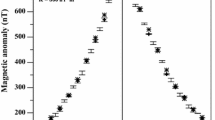Abstract
We have developed three different least-squares minimization approaches to determine, successively, the depth, dip angle, and amplitude coefficient related to the thickness and density contrast of a buried dipping fault from first moving average residual gravity anomalies. By defining the zero-anomaly distance and the anomaly value at the origin of the moving average residual profile, the problem of depth determination is transformed into a constrained nonlinear gravity inversion. After estimating the depth of the fault, the dip angle is estimated by solving a nonlinear inverse problem. Finally, after estimating the depth and dip angle, the amplitude coefficient is determined using a linear equation. This method can be applied to residuals as well as to measured gravity data because it uses the moving average residual gravity anomalies to estimate the model parameters of the faulted structure. The proposed method was tested on noise-corrupted synthetic and real gravity data. In the case of the synthetic data, good results are obtained when errors are given in the zero-anomaly distance and the anomaly value at the origin, and even when the origin is determined approximately. In the case of practical data (Bouguer anomaly over Gazal fault, south Aswan, Egypt), the fault parameters obtained are in good agreement with the actual ones and with those given in the published literature.










Similar content being viewed by others
References
Abdelrahman, E.M., Bayoumi, A.I., El-Araby, H. M. (1989), Dip angle determination of fault planes from gravity data. Pure and Applied Geophysics, 130, 735–742.
Abdelrahman, E.M., El-Araby, T.M. (1993), A least-squares minimization approach to depth determination from moving average residual gravity anomalies, Geophysics, 59, 1779–1784.
Abdelrahman, E.M., Essa, K.S. (2013), A new approach to semi-infinite thin slab depth determination from second moving average residual gravity anomalies, Exploration Geophysics, 44, 185–191.
Abdelrahman, E.M., Essa, K.S., Abo-Ezz, E.R. (2013), A least-squares window curves method to interpret gravity data due to dipping faults, Journal of Geophysics and Engineering, 10, 025003.
Abdelrahman, E.M., El-Araby, H.M., El-Araby, T.M., Abo-Ezz, E.R. (2003), A least-squares derivatives analysis of gravity anomalies due to faulted thin slabs, Geophysics, 68, 535–543.
Abdelrahman, E.M., Radwan, A.H., Issawy, E.A., El-Araby, H.M., El-Araby, T.M., Abo-Ezz, E.R. (1999), Gravity interpretation of vertical faults using correlation factors between successive least-squares residual anomalies, The Mining Pˇribram Symp. Mathematical Methods in Geology, MC2-1-6.
Agocs, W.B. (1951), Least-squares residual anomaly determination, Geophysics, 16, 686–696.
Davis, J.C. (1973), Statistics and data analysis in geology, Wiley & Sons, Inc., New York.
Eliseyeva, I.S. (1998), Methodical rules for the interpretation of gravimetrical and magnetometrical data by means of quasi-singular points method, in Russian, VNII Geofizika Moscow.
Essa, K.S. (2013), Gravity interpretation of dipping faults using the variance analysis method, Journal of Geophysics and Engineering, 10, 015003.
Evans, K., Beavan, J., Simpson, D. (1991), Estimating aquifer parameters from analysis of forced fluctuations in well level: An example from the Nubian Formation near Aswan, Egypt: 1. Hydrogeological background and large-scale permeability estimates, Journal of Geophysical Research, 96 (B7), 12,127–12,137.
Geldart, L.P., Gill, D.E., Sharma, B. (1966) Gravity anomalies of two dimensional faults, Geophysics, 31, 372–397.
Green, R. (1976), Accurate determination of the dip angle of a geological contact using the gravity method, Geophysical Prospecting, 24, 265–272.
Griffin, W.R. (1949), Residual gravity in theory and practice, Geophysics, 14, 39–58.
Gupta, O.P. (1983), A least-squares approach to depth determination from gravity data, Geophysics, 48, 357–360.
Gupta, O.P., Pokhriyal, S.K. (1990), New formula for determining the dip angle of a fault from gravity data, SEG Expanded Abstract, 9, 646–649.
Hammer, S. (1974), Approximation in gravity calculations, Geophysics, 39, 205–222.
Lines, L.R., Treitel, S. (1984), A review of least-squares inversion and its application to geophysical problems, Geophysical Prospecting, 32, 159–186.
Nettleton, L.L. (l976), Gravity and magnetics in oil prospecting, Mc-Graw Hill Book Co.
Paul, M.K., Datta, S., Banerjee, B. (1966), Direct interpretation of two dimensional Structural fault from gravity data, Geophysics, 31, 940–948.
Phillips, J.D., Hansen, R.O., Blakely, R.J. (2007), The use of curvature in potential-field interpretation, Exploration Geophysics, 38, 111–119.
Press, W.H., Flannery, B.P., Teukolsky, S.A., Vetterling, W.T. (1986) Numerical Recipes, The Art of Scientific Computing, Cambridge: Cambridge University Press, London.
Rao, R.S.B., Radhakrishnamurthy, I.V. (1965), Some remarks concerning residuals and derivatives, Pure and Applied Geophysics, 61, 5–16.
Reid, A.B., Allsop, J.M., Gmser, H., Millett, A.J., Somerton, I.W. (1990), Magnetic interpretation in three dimensions using Euler deconvolution, Geophysics, 55, 80–91.
Telford, W.M., Geldart, L.P., Sheriff, R.E., Key, D.A. (1976), Applied geophysics, Cambridge Univ. Press, London.
Utyupin, Yu.V., Mishenin, S.G. (2012), Locating the sources of potential fields in areal data using the singularity method, Russian Geology and Geophysics, 53, 1111–1116.
Acknowledgments
The authors thank the editors, particularly, Prof. Valeria Barbosa, the Associate Editor, and three capable reviewers for their excellent suggestions and the thorough review that improved our original manuscript.
Author information
Authors and Affiliations
Corresponding author
Rights and permissions
About this article
Cite this article
Abdelrahman, E.M., Essa, K.S. Three Least-Squares Minimization Approaches to Interpret Gravity Data Due to Dipping Faults. Pure Appl. Geophys. 172, 427–438 (2015). https://doi.org/10.1007/s00024-014-0861-4
Received:
Revised:
Accepted:
Published:
Issue Date:
DOI: https://doi.org/10.1007/s00024-014-0861-4




